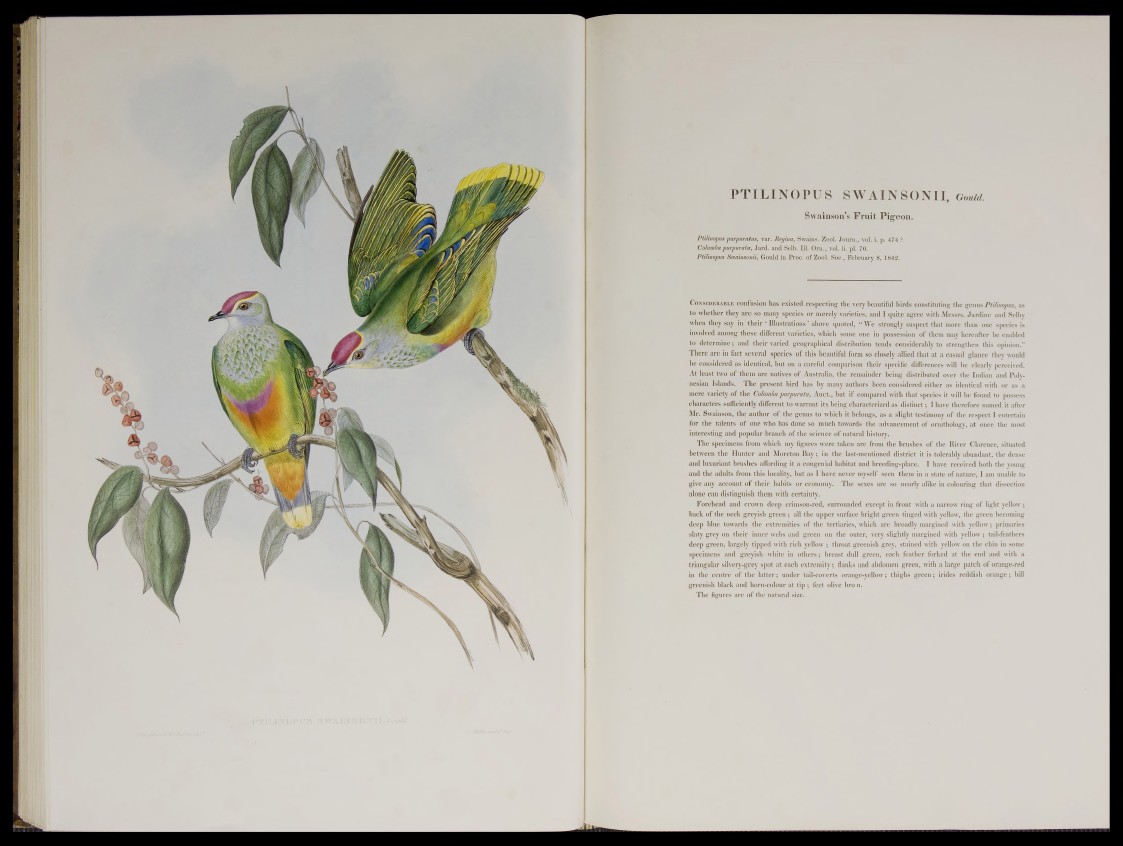
PTILINOPUiO SWAINSONII, Gould.
Swainson’s Fruit Pigeon.
Ptilinopus purpuratus, var. Regina, Swains.
Columba purpurata, Jard. and Selb. I l l ('-
Ptilinopus Swainsonii, Gould in Proc. o&Zdi|| Soc., February 8, 18 ^ p fl^
Considerable confusion has existed respecting the very beautiful' birds constituting the genus Ptilinopus, as
to whether theyaregsb. many; species or f ||r^ ly varieties, andid^qinte^gree with Messrs. Jardine and Selby
when they say in their JIllustrations’ above footed, “ We strongly suspect that more than one species is
Waived among these different* varieties,^^.cb some orie^irr-pO^lsipn off them may hereafter he enabled
to determine; a n d | | |g varied geographical distribution tends considerably to strengthen this opinion.”
fherg; aye in fact seygcail species of this^eautiful form so c l o s e l y c a s u a l glance they would
he considered on a careful comparison th,eir specific differences will be clearly perceived.
At least twoof themare natives of Australia, th e^ ^ p ld e r^ b e i^ ^B fe tn iF ed ^ o v e r the Indian and Polynesian
Islands. The present bird has by many authors been considered « g yB as identical with^or as a
mere variety of the Columba purpurata, Auct./ Jtftt,if compared with that species it will be found to possess
characters s u ^ ^ ^ f e ^ f e e i i t to warrant its being characterized as distinct; Thave therefore named it after
Mr. $wainscj§| the author of the genus to which it belongs, as a slight testim^ybfx#ie respect I entertain
:fon~the talents of one who has done so much td’^ayds the advancement of ^ornitndlogyf St once the most
popular branch of the science offnaturaj history.
The specimens from which .^ ^ g if r e ^ wgre taken are from the brushes offthe River Clarence, situated
between the Hunter and MoretonBay l | | J t h e last-mentioned district it Mbolerably abundant, the dense
and luxuriant brushes affording it a congenial habitat and breeding-place. I have received both the young
and the adults from this locality, but as I have n ev ^ f^ y ^ lf; seen tjigm jn a state of natUre, Tamimableto
give any account of their habits or ecohomy. The sexes are so nearly alike in colouring that dissection
alone can distinguish them with certainty.
Forehead and crown d e e p e x c e p t in front with a narrow ring of light yellow;
back of the neck greyish green; all the.upper surfabebright greCO: tinged with yellow, the green becoming
-deep blue towards the extremities of the tertiaries, which are broadly margined with yellowy primaries
slaty grey on their inner webs and green onthc outer, very slightly margined with yellow; tail-feathers
■deep green, largely tipped with^ich yellow; throat greenish.,grey, stained with yellow on the chin in some
specimens and. gre^sh white in .others; breast dull green, each feather forked at the end and with a
triangular silvery-gyey spot at &aelj extremity; flanks and abdomen green, wi$k h large patch of orange-red
in the centre of tffe latter; under taiL-coverts orange-yellow; thighs-green; irides reddish orange; biff
greenish black and horn-cnlnwr at tip ; feet olive b j o i ^ r »
The figures are of the natural size.